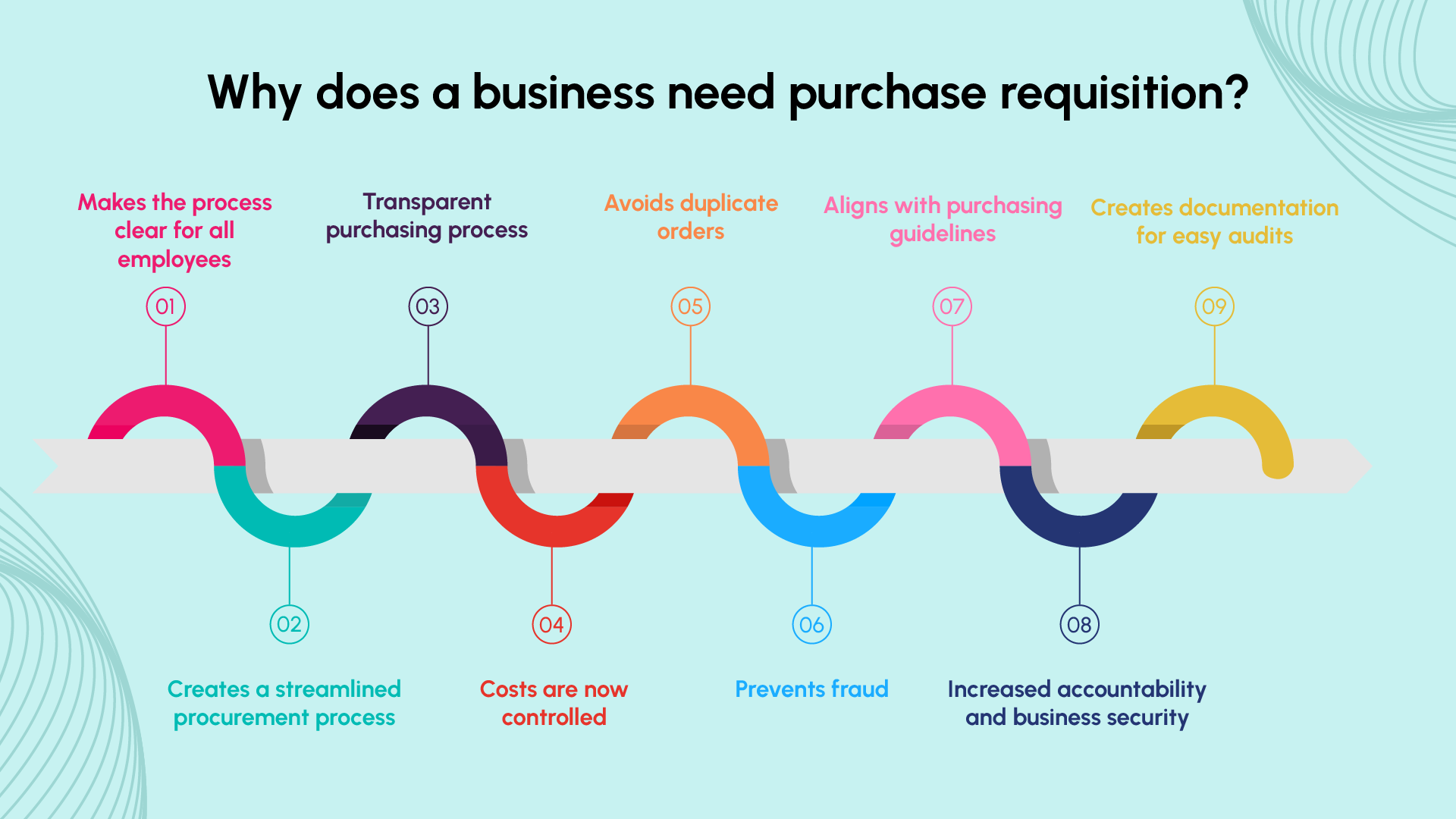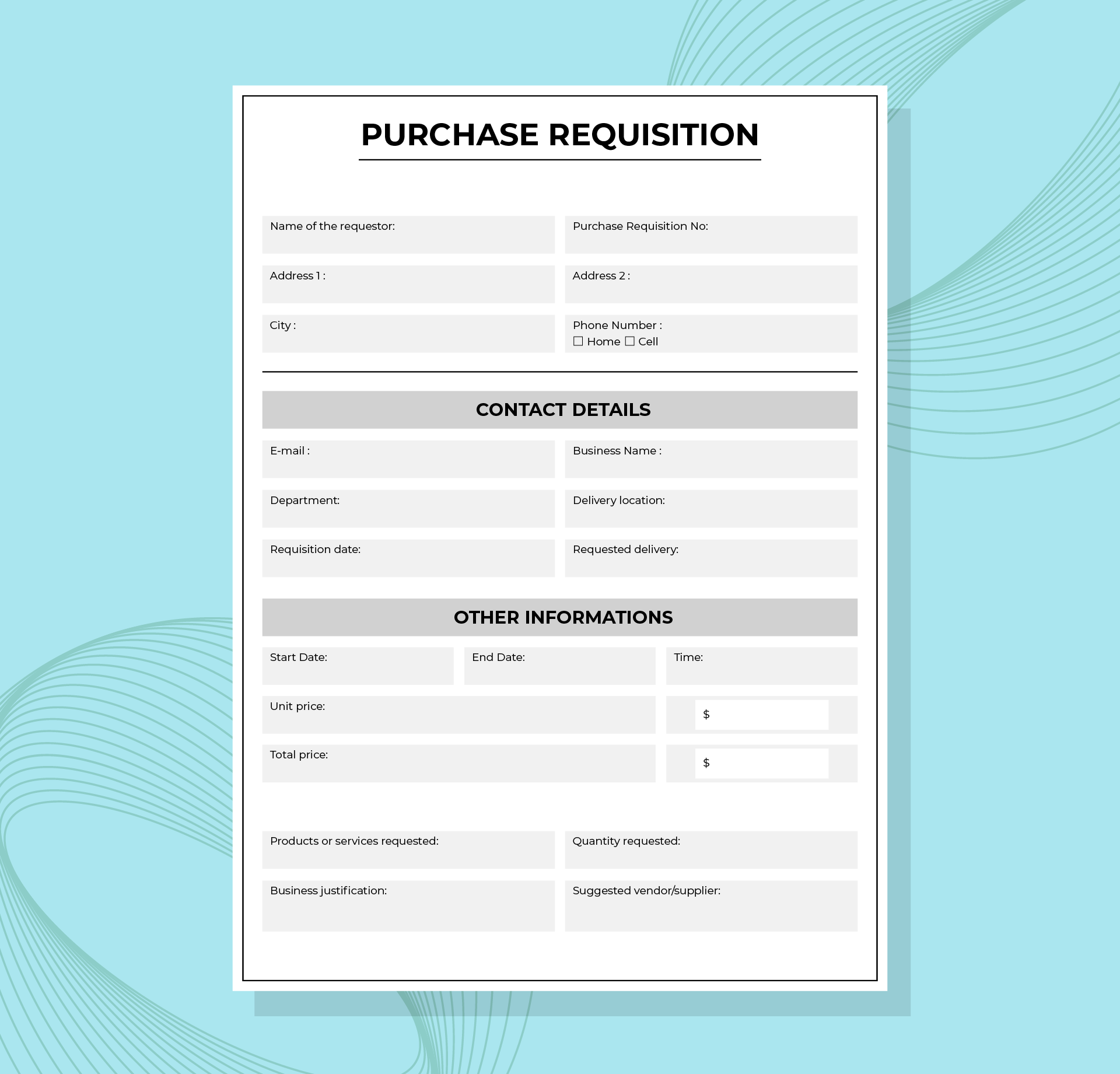Every business has unique operational requirements to flourish, ranging from basic needs such as office supplies and equipment to more complex goods and services. The real challenge is with accessing these necessities but sourcing them from multiple vendors and suppliers with inefficient procurement practices.
Empowering your departmental heads and line managers with the leeway to act in the company best interest and secure what is needed may not be a bad thing when you have the right controls over the procurement process.
Unfortunately, this is not always the case, as numerous businesses lack a suitable purchase requisition workflow to effectively track, manage, and supervise the procurement process, exposing them to inflated expenses and fraud.
When done right, the purchase requisition process can be a boon that helps businesses mitigate such problems. Although for purchase requisitions to be accurate and most effective, companies must devise an effective requisition form, eliminate redundant processes, create standardized guidelines for filing purchase requests, and manage them correctly.
This article is an in-depth guide to purchase requisitions to provide readers with a better understanding of the purchase requisition process, the best practices in purchase requests, requisition forms, and how to source what your enterprise needs without overspending.
Key Takeaways
- A purchase requisition is a document your employees or departmental heads must fill out to procure certain goods or services that assists in performing business activities.
- Purchase requisition and purchase order are not the same.
- Purchase requisition refers to initiating the procurement process where an item is requested by an employee internally, and a purchase order is a legally binding document sent to the supplier detailing the item, quantity, price, payment terms, and delivery timeframe of the goods or services the employee requires.
- Businesses need purchase requisition because it clarifies the procurement process for all employees, creates a transparent procurement process, streamlines the purchasing process, controls costs, prevents duplicate orders, quashes fraud, aligns purchases with company guidelines, increases accountability and business security, and simplifies audits.
- A purchase requisition form contains the requestor name, requisition date, department, delivery location, items requested, item quantity, unit price, total price, business justification, and suggested vendor/supplier.
- The purchase requisition workflow follows the employee as they identify a requirement, fill out a purchase requisition form, await the Line manager approval post inventory checks and final screening, generate a purchase order, item delivery, and invoice payment.
- Automated procurement software such as Zapro significantly helps businesses create a streamlined purchase requisition process that enhances the purchase requisition process accuracy, transparency, and effectiveness while eliminating overspending, errors, and fraud.
In this informative read, we will cover the following topics:
- What is Purchase Requisition?
- Why does a business need purchase requisition?
- How do purchase requisitions work?
- What does a purchase requisition form look like?
- The purchase requisition workflow
- Manual vs. automated purchase requisition
- Automate purchase requisition workflows with Zapro
What is Purchase Requisition?
Simply put, a purchase requisition is a document your employees or departmental heads must fill out to procure certain goods or services that assists in performing business activities.
This document serves as a request for an item that, when approved by the relevant organizational procurement authorities, can be used to generate a purchase order for suppliers and vendors to carry out procurement.
Purchase requisition vs. purchase order
We have witnessed that the terms purchase requisition and purchase order are often used interchangeably. It is incorrect to do so, as while both are a part of the procurement process, they are not the same.
The primary difference is that a purchase requisition initiates the procurement process and is a request an employee (the requester) forwards to organizational managers and procurement groups requesting a particular product or service needed for business operations.
On the other hand, a purchase order is a legally binding document sent to the supplier detailing the item, quantity, price, payment terms, and delivery timeframe of the goods or services the employee intended to purchase.
Why does a business need purchase requisition?
Here are some of the reasons why your business needs purchase requisition:
- Makes the process clear for all employees
- Creates a streamlined procurement process
- Transparent purchasing process
- Costs are now controlled
- Avoids duplicate orders
- Prevents fraud
- Aligns with purchasing guidelines
- Increased accountability and business security
- Creates documentation for easy audits
Let dig deeper.

1. Makes the process clear for all employees
By implementing a systematic purchase requisition process, you ensure you set a standardized set of instructions for your employees on handling purchase requests.
Including purchase requisition into your workflow will guarantee increased clarity for all organizational employees, procurement teams, and managers on the protocols for purchasing goods and services.
2. Create a streamlined procurement process
Streamlined purchase requisition by digitization can significantly enhance the overall process of procurement, where sourcing the items the business requires becomes much more straightforward for all stakeholders involved.
3. Transparent purchasing process
Most businesses that don’t follow the best practices in purchase requisition suffer from a general lack of clarity of what and why their employees and departments are purchasing. This can be entirely mitigated through digitized purchase requisition that keeps all relevant organizational stakeholders in the loop.
This feat is difficult to achieve when relying on a manual purchase request workflow.
4. Costs are now controlled
The most practical benefit of implementing purchase requisition is that it lets you dramatically control costs. With purchase requisition, you ensure that all purchase requests are justified and fall within the corporate budget.
Entrusting the purchase requisition process to a central purchasing authority that handles all the organizations purchasing can help you negotiate better deals and payment terms with prospective suppliers and vendors.
5. Avoid duplicate orders
Sometimes, duplicate orders from different employees occur for the same products or services. The purchase requisition process dramatically improves your organizational ability to identify duplicated item requests that may cause significant overspending if overlooked.
6. Prevent fraud
Unfortunately, employee fraud is one of the most significant byproducts of having little to no oversight in your purchasing process.
A transparent purchase requisition process helps uncover and quash cases where employees attempt to defraud their companies for personal gain through fabricated or duplicated purchase orders.
7. Align with purchasing guidelines
The proper purchasing guidelines can keep purchase requests in line with your company purchasing guidelines ensuring that the right vendors with the most feasible rates get the purchase orders.
8. Increased accountability and business security
One of the primary benefits of purchase requisitions is that it helps businesses maintain a comprehensive record of all purchased items or services. These records detail the employee or department that requested them, quantity, costs, and all other relevant data.
When fraud is suspected, the business can easily track down its source and hold the responsible party accountable, thus enhancing business security.
9. Create documentation for easy audits
Purchase requisitions additionally maintain readily available information on purchase requests and approvals that is highly useful in the event of an audit.
How do purchase requisitions work?
To understand how purchase requisitions work, consider a situation where your marketing department requires new computers for its team members to replace outdated tech and boost productivity. The requester must initiate the purchase requisitions process by filling out a requisition form describing the items preferred specifications, cost, quantity, and budget.
It would then have to propose it to the relevant decision-makers for review. The requisition request is then assessed if it’s a justifiable necessity by the reviewers, typically the company procurement department, departmental line managers, and key decision-makers.
If approved, the procurement team will identify potential suppliers, inquire about prices, receive quotes, negotiate rates, and purchase the most feasible option.
What Does a Purchase Requisition Form Look Like?

The purchase requisition form typically needs the following fields:
The purchase requisition workflow
While the purchase requisition workflow differs from business to business, this is what it would generally look like:
- Employee identifies a requirement
- Employee fills out a purchase requisition form
- Requisition form is sent to the line manager for approval
- Inventory department checks requirements against stock
- Final screening by the purchasing department
- Purchase order is generated
Let’s take a closer look at these steps.
Step 1 – Employee identifies a requirement
The first step of the purchase requisition workflow is when an employee identifies the need for a product or service. It could be as simple as an HR manager identifying a shortage of office stationery.
Step 2 – Employee fills out a purchase requisition form
Once the requirement is identified, the employee uses either a purchasing system or fills out a manual form detailing all relevant information about the desired item and why they believe it is necessary.
Step 3 – Requisition form is sent to the line manager for approval
Now that the form is filled, it is then sent to the line manager or departmental head for review. The reviewer assesses the requisition request and deems if it is an acceptable request.
In some cases, when the purchase request has high associated costs, it may require the attention and assessment of multiple decision-makers before proceeding with the procurement process.
Step 4 – Inventory department checks requirements against stock
Most businesses require a mandatory inventory check before the request is approved and forwarded to the purchasing group or department. It is to double-check if the item is, in fact, not available in stock.
The request will move to the next stage if there is a clear indication of depleted stock or unavailability. This stage is mainly to avoid wasteful purchasing that puts businesses at a loss.
Step 5 – Final screening by the purchasing department
It is now time for the purchasing department to perform a final review of the purchase request to confirm if it’s a justifiable purchase and has been approved by the relevant managers.
If there are gaps in the requisition data, the purchasing department may request additional details and may reject the request if uncertainty remains and appropriate justifications aren’t provided.
In most cases, the rejected request is sent back to the requester with the proper reasoning. Exceeding purchasing limits, duplicated orders, and unnecessary item requests are examples of reasons why requests can be rejected.
Step 6 – Purchase order is generated
When all prior stages are successful, and the final screening by the purchasing department is approved, the purchase order is created and forwarded to the respective vendor. The vendor then approves or denies the purchase order depending on their ability to fulfill it. If the vendor accepts the purchase orders terms, it becomes a legally binding contract.
Manual vs. Automated Purchase Requisition
When contemplating between manual and automated purchase requisition, it is essential to consider both pros and cons before making a final decision.

1. Manual purchase requisition
The manual purchase requisition workflow may provide a high level of control and customization into the process, accommodate complex requirements, and provide closer scrutiny of each requisition.
Although, it can be a tedious process requiring considerable manual paperwork and processing, increasing the chances of errors, delays, and misplaced requisition forms that may dramatically slow down the purchasing process.
In such instances, the lack of real-time visibility and transparency into the purchase requisitions process makes identifying and rectifying errors all the more difficult.
This lack of transparency in manual purchase requisition also makes it a challenge for coordination between employees, departments, managers, and stakeholders, negatively impacting performance and causing further operational problems.
2. Automated purchase requisition
On the other hand, the automated purchase requisition process offers a streamlined and efficient alternative workflow that relies on quicker and more accurate data entry.
This entirely digitized process allows employees to utilize standardized templates and quickly share their purchase requests with the relevant reviewers ensuring quick reviews and approval time with minimal manual effort.
Automated purchase requisition processes are integrated with the enterprises inventory and accounting systems reducing the chances of non-compliant purchasing, overspending, errors, and fraud.
One must invest in the right software and technology to get the best out of automated purchase requisitions and experience immediate results.
Automate Purchase Requisition Workflows With Zapro
If you’re among the many burdened with the cumbersome manual purchase requisition process, it may be time to consider a streamlined, automated alternative with Zapro.
Our procurement software significantly enhances the purchase requisition processes accuracy, transparency, and effectiveness.
Here’s how you can automate your purchase requisition process with Zapro:
- First, create custom standardized requisition forms with fields relevant to your business requirements. Then, submit the form electronically through Zapro’s software.
- Zapro’s automated workflows ensure you route your purchase requisitions to the appropriate personnel for review and approval. Depending on the item’s size, the approval can be automatic or forwarded to the finance department for additional review.
- Once the purchase requisition is approved, Zapro’s procurement software automatically generates a purchase order. Once the purchase order is generated, it is automatically sent to the supplier, eliminating manual processing and reducing the risk of errors or delays.
- After the supplier delivers the goods or services, Zapro’s procurement software verifies the items and initiates payment through the accounts payable process ensuring timely payments through a streamlined payment process.
To wrap up, by automating your purchase requisition process with Zapro, you will instantly notice improved accuracy and efficiency, faster processing time, reduced risk of errors or fraud, better cost control, and enhanced visibility and control over your procurement operations.
Automate your purchase requisition process through Zapro’s procurement software and automate your purchase requisition process so you don’t have to worry about errors and inaccuracies disrupting your business operations.
